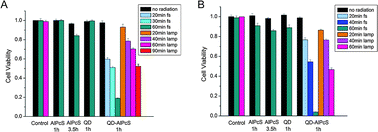Femto-second laser beam with a low power density achieved a two-photon photodynamic cancer therapy with quantum dots†
Abstract
Focusing the femto-second (fs) laser beam on the target was the usual way to carry out a two-

* Corresponding authors
a
State Key Laboratory of Surface Physics and Department of Physics, Key Laboratory of Micro and Nano Photonic Structures (Ministry of Education), Fudan University, Shanghai 200433, People's Republic of China
E-mail:
jychen@fudan.edu.cn
Fax: +86-21-65104949
Tel: +86-21-65643084
b Department of Chemistry, School of Interdisciplinary Bioscience and Bioengineering, Pohang University of Science and Technology (POSTECH), San 31, Hyoja-Dong, Nam-Gu, Pohang, Gyeong-Buk, South Korea
Focusing the femto-second (fs) laser beam on the target was the usual way to carry out a two-

 Please wait while we load your content...
Something went wrong. Try again?
Please wait while we load your content...
Something went wrong. Try again?
K. Chou, N. Won, J. Kwag, S. Kim and J. Chen, J. Mater. Chem. B, 2013, 1, 4584 DOI: 10.1039/C3TB20928H
To request permission to reproduce material from this article, please go to the Copyright Clearance Center request page.
If you are an author contributing to an RSC publication, you do not need to request permission provided correct acknowledgement is given.
If you are the author of this article, you do not need to request permission to reproduce figures and diagrams provided correct acknowledgement is given. If you want to reproduce the whole article in a third-party publication (excluding your thesis/dissertation for which permission is not required) please go to the Copyright Clearance Center request page.
Read more about how to correctly acknowledge RSC content.
 Fetching data from CrossRef.
Fetching data from CrossRef.
This may take some time to load.
Loading related content
